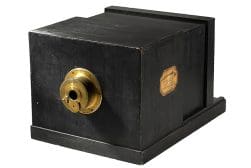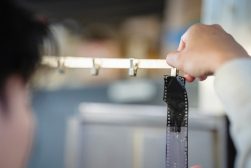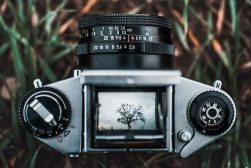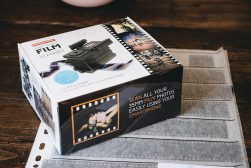
When Were Cameras Invented? A History of Photography
When did everyone start using cameras? When was the first photo in the world taken? Learn all about the history of photography in this enlightening guide.
Learn | Photography Guides | By Ana Mireles
Have you ever wondered when were cameras invented?
The history of photography is a fascinating journey that started as a room-size camera obscura and has now reached the small digital cameras that we carry on our smartphones today.
If you want to learn more about the history of photography, keep reading!
When Was the Camera Invented?
The camera obscura
In the early 1500s, Ibn al-Haytham used the first pinhole camera to see a solar eclipse. However, the camera obscura concept was presented by Aristotle in the 4th century BC and in the Chinese text Mozi. It was also clearly described by Leonardo Da Vinci in Codex Atlanticus.
A camera obscura is a dark room with a small hole on one of the sides – through it, the light passes and forms an upside-down image on the opposite wall. This principle is used to make pinhole cameras and it’s still the bases for modern photographic cameras.
The photographic process
Even if the design of the camera obscura kept evolving until it became smaller and even included a lens, still the resulting image couldn’t be recorded.
It wasn’t until 1926 when Nicéphore Niépce finally found a formula that kept the image on physical support for a lasting period of time – it’s still visible today. The process he invented is called heliography, and it’s based on the use of a photosensitive material called bitumen of Judea.
Since the exposure time was very long, the subject needed to be static – in this case, is the view from his window. As far as the camera goes, he was using a portable camera obscura.
The patent for photography
Louis Jacques Mandé Daguerre, a painter and set decorator, learned how to use the camera obscura to paint his canvases. He also made performances called Dioramas, where he would show animated figures through the effects of lighting on stage.
In 1827 Niépce and Daguerre met and discussed their shared interest in fixing images, as Daguerre had done several chemical experiments himself. In 1829 they started a partnership, and by 1832 they invented a process called physautotype.
After Niépce’s death, Daguerre continued the research and presented the daguerreotype to the French Académie des Sciences in January 1839.
On August 19th 1939, he presented and explained the process – giving birth to what we know today as photography. This is why August 19th is known as World Photography Day.
The earliest cameras
The first photographic camera was a daguerreotype camera – Alphonse Giroux did it in 1839. This makes it technically the world’s first camera that could record images. This is also why some regard him as the person who invented the first camera. The design was a bit more sophisticated than simple pinhole cameras. It was a double box camera – on the outer box, there was a landscape lens, and the internal box supported the image plate. You could focus the image by sliding the inside box back and forward.
Charles Chevalier, the optics supplier for Daguerre and Niépce, developed his own camera version. It also featured a double-box design, but it was more portable and had a faster lens. With this camera, the exposure could be as fast as 3 minutes.
By 1841, a new camera design was made public, and it provided different apertures by turning a metal disc with three different sized holes.
New cameras, new processes, new uses
After the daguerreotype, the preferred photographic process was the wet collodion. It required the support (glass or iron plates) to be coated right before being used so it would still be wet when you exposed it to light – hence the name wet collodion.
This technique allowed the development of more sophisticated cameras. In 1864, Jules Bourdin patented a design called Dubroni Pocket Camera. It was produced in different shapes and sizes, but the main difference from its predecessors was that you could coat and develop the plates inside the camera.
Other improvements made to the photographic camera during this period were the use of bellows for focusing and the multiple lenses that allowed capturing various images on a single plate.
The introduction of roll film cameras
One of the most significant breakthroughs in the history of camera technology was the switch from plates to photographic film. At first, George Eastman manufactured paper film – which later turned into celluloid. With this invention, he developed the first film camera called Kodak, available in 1888.
The Kodak was a box camera with a fixed-focus lens and was the world’s first camera that used film. It was preloaded with a 100 exposure film. Once used, it would be sent back to the company to be developed and loaded with a new film. The advertising copy read, “You press the button; we do the rest”, which turned it into the first consumer camera in history.
How Much Do You REALLY Know About Photography?! 🤔
Test your photography knowledge with this quick quiz!
See how much you really know about photography...

In 1900, Kodak released its new iconic camera – the Brownie. It was so inexpensive and easy to use that it was advertised for children. Although it was loved by adults, too – many iconic images from the war, the Titanic, and other historical moments were taken with a Brownie.
Kodak’s Brownie cameras introduced the concept of snapshot and made photography available for the mass market. They used 120mm roll film.
The arrival of the 35mm film
If you have an analog camera, it likely uses a 35mm roll film since this was the most popular format in analog photography. Even the transition to digital camera technology used it as a reference – a full-frame sensor is the size of a 35mm photogram.
The 35mm film photography didn’t become popular overnight. The first 35mm camera invented was patented in 1908 – but it was never produced.
Then, in 1913 the first camera made it to the market – it was a model invented by Jules Richard Homeos. It wasn’t until 1925 when the Leica I arrived on the market that the 35mm film was popularised.
Many camera manufacturers embraced this format and offered multiple models. By 1959, the 35mm roll film was the standard, and Nikon released the F model targeting professional photographers.
Single-lens reflex cameras
Even though single and twin-lens reflex cameras were already available – it wasn’t until World War II ended that a compact SLR became popular.
In 1947, the eye viewfinder revolutionised single-lens reflex cameras thanks to the introduction of a pentaprism.
Instant cameras
In 1948 there was another breakthrough in the history of the camera – the Polaroid model 95 made its appearance. Since then, Polaroid cameras have become the most popular for instant photography.
The arrival of digital photography
Once again, Kodak planted another landmark in the history of cameras when its engineer Steve Sasson created the first digital camera. This revolution produced the first camera photo that was not captured using chemicals on a strip of plastic but rather on digital sensors. However, it wasn’t until 1988 that the first digital consumer camera reached the market – and it was a Fuji.
Once the digital technology reached the cameras, coming up with an image-manipulation software was a natural step. The first one was Digital Darkroom for Machintosh – then the first version of Photoshop was launched in 1990.
By 1991, Kodak came up with the first DSLR camera. A digital SLR camera works in the same way as an SLR, except that it has a digital sensor where the film used to be. Also, you can see the image immediately after taking it on the camera’s LCD screen.
Image sensors improved in only a few years, gaining more quality and resolution on a regular basis. Even today, the technology that goes into camera sensors keeps improving.
The revolution of the camera phones
In 1999 the first camera phone reached the market – it was the Kyocera visual phone. You could store 20 JPEGs on it and send them via email.
The popularity of these devices quickly overturned the photography world – so much so that by 2003 more camera phones were sold than photographic cameras.
Phone manufacturers kept adding features and technical improvements to make camera phones better and more appealing to the average consumer and photography lovers. Then, in 2007 the iPhone came along, and smartphone photography made its way into the artistic and professional field.
When Were Different Types of Cameras Invented?
- Security Cameras – Otherwise known as CCTV, security cameras have their origin in 1927 by Leon Theremin. Another important moment in CCTV history was 1942 when Siemens AG installed Walter Brunch’s system in Germany. Then, it became available to the public in 1949.
- Spy Cameras – A spy camera is a small hidden device. Many models are considered the first one depending on their size and shape. For example, the Minos subminiature camera was launched in 1922. However, one of the most famous is the Minox Riga, invented in 1938 by Walter Zapp. Then, after the 1950s, spy cameras started taking different shapes – first, they were hidden in buttons, and by the 1990s, the first pen cameras appeared on the market.
- Dash Cameras – The windshield camera invented by H. C. Fairchild is considered the first dashcam. You can see a dash camera mounted on a police car in a Science Magazine issue from 1939.
- Rearview Cameras – The Buick Centurion, launched in 1956, was the first car featuring a rearview camera. Since then, they’ve become more and more popular, with a significant increase in the last few years. Since 2018 they have been required by law on all new US-made cars.
- Pet Cameras – A home security camera specially designed to care remotely for your pets and toss them treats was launched in 2016 by Tomofun. The product is called Furbo, and it launched as a crowd-funded campaign that raised its target in less than 8 hours – it’s still a very successful pet camera regardless of the multiple devices now available on the market.
- Portable Cameras – The Kodak camera was the first portable and easy to use. It launched in 1888, and it was a handheld box with a 100-exposure roll loaded.
- Film Cameras – George Eastman released a film camera called Kodak in 1888 with a roll of film loaded inside.
- Digital Cameras – Steven Sasson developed the first digital camera for Eastman Kodak in 1975.
- DSLR Cameras – The first DSLR was invented in 1991 by Kodak.
- Mirrorless Cameras – The first mirrorless camera that made its way to the market was an Epson in 2004. Then, in 2008 the Panasonic Lumix DMC – G1 was the first one with interchangeable lenses.
- Movie Cameras – The first movie camera using celluloid film dates to 1895; it’s attributed to the Lumière brothers.
- Color Cameras – There isn’t a color camera as such. The invention of the first color photographic process was Autochrome in 1907, and it could be done with the same cameras as monochrome photography.
- 360-degree cameras – The first camera to record 360 degrees of the horizon was patented in 1887.
- Action Cameras – The first prototype for an action camera belongs to Nicholas Woodman, and it was done in 2004.
History of Photography Timeline
1500 First camera obscure.
1826 First photographic image was made by Nièpce.
1839 French inventor Daguerre makes public his photographic process – the daguerreotype.
1841 The negative-positive process is invented.
1845 First panoramic camera.
1860 Invention of the Reisekamera (the portable large format camera).
1888 First Kodak camera with film.
1900 Release of the Kodak Brownie.
1907 Invention of the Autochrome.
1925 Launch of the Leica I – the first small format camera.
1936 Invention of color film.
1947 DualFlex – twin-lens reflex.
1947 The first instant camera came out – the Polaroid Model 95.
1948 Hasselblad 1600F – First single-lens medium format camera
1853 Invention of the first stereoscopic camera.
1861 Invention of the SLR.
1963 First camera with autofocus by Canon.
1975 First Kodak digital camera.
1986 Quicksnap – first disposable camera.
1974 First fully automatic camera.
1990 Dycam model 1 – the first commercially available digital camera.
1991 Kodak DCS SLR.
1994 Apple entered the photography world with the QuickTake 100.
1999 The first phone with a built-in camera – Kyocera Visual Phone.
2004 First consumer mirrorless camera by Epson.
2007 The first iPhone was released.
2008 Panasonic Lumix DMC – G1 – first mirrorless camera with interchangeable lenses.
History of the Camera FAQs
When was the first camera invented?
Technically, the first camera ever made was in 1839, by the inventor Alphonse Giroux. This pertains to the world’s first camera by modern definition.
When was the first photo in the world?
The first photograph in history is attributed to Nicéphore Niépce, and it dates to 1826. The technique is heliography, and the subject is the view from an upstairs window in Burgundy.
Did cameras exist in the 1600s?
By the end of the 1500s and early 1600s, the camera obscura was improved with the addition of a concave lens. In 1604 Johannes Kepler used it for astronomical applications. Later on, it became more portable, and many artists used it to draw.
Did cameras exist in the 1700s?
In the 1700s, the camera obscura continued to evolve. By now, it was shaped like a book – for example. It played a more important role as a supporting tool for painters and artists.
Did cameras exist in the 1800s?
In the 1800s, the camera made a giant leap, mainly because there was finally a way to permanently register the images captured by the device. During this period, cameras became more portable and easier to use – to the point of becoming available for the average user.
Final Words
As you can see, the history of cameras, from the first photograph up to our smartphones, has been a wild ride. Of course, there were many inventors and developments that I couldn’t mention in such a short article.
However, I hope it was enough to pique your curiosity so you can dig for some more information on the topic of your interest.
If you have any questions or want to add something to this quick trip down memory lane – please do so in the comments.

Check out these 8 essential tools to help you succeed as a professional photographer.
Includes limited-time discounts.













